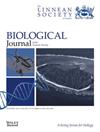Genetic and morphometric variation in populations of Partamona cupira and Partamona mulata, stingless bees endemic to the Cerrado biome in Brazil
IF 1.5
3区 生物学
Q3 EVOLUTIONARY BIOLOGY
引用次数: 0
Abstract
The Brazilian Cerrado biome stands out as a biodiversity hotspot, boasting a rich flora and endemic species. However, human activities have significantly altered nearly 80% of its area. Partamona cupira and Partamona mulata are stingless bees from the Cerrado that have received limited attention regarding their intraspecific variation. Our objective was to estimate the genetic and morphometric variation across the geographical distribution of these bees. We accomplished this by sequencing mitochondrial DNA (mtDNA) regions (COI and CytB genes) and obtaining phenotypic traits of wings using landmark-based approaches. Genetic analyses revealed a common pattern found in Partamona bees, characterized by high haplotype diversity, low nucleotide diversity, and the presence of exclusive low-frequency haplotypes. These characteristics support the hypothesis that stingless bees exhibit genetic structuring in their mtDNA due to their colony-dependent mode of reproduction. We observed an association between morphometric and geographical distances, suggesting that phenotypic gradients may be produced by environmental factors. The time to the most recent common ancestor for P. cupira and P. mulata was estimated at 147.8 and 284.0 kya, respectively. Demographic analyses suggested population equilibrium for both species, indicating that climatic fluctuations during the Pleistocene had no impact on the distributions of P. cupira and P. mulata.巴西塞拉多生物群落特有无刺蜂 Partamona cupira 和 Partamona mulata 种群的遗传和形态变异
巴西塞拉多生物群落是生物多样性的热点地区,拥有丰富的植物和特有物种。然而,人类活动极大地改变了其近 80% 的面积。Partamona cupira和Partamona mulata是塞拉多地区的无刺蜜蜂,它们的种内变异受到的关注有限。我们的目标是估计这些蜜蜂在不同地理分布上的遗传和形态变异。为此,我们对线粒体 DNA(mtDNA)区域(COI 和 CytB 基因)进行了测序,并采用基于地标的方法获得了翅膀的表型特征。遗传分析表明,Partamona 蜜蜂中存在一种共同的模式,其特点是单倍型多样性高、核苷酸多样性低以及存在排他性的低频单倍型。这些特征支持了这样的假设,即无蛰蜂的 mtDNA 具有遗传结构,这是因为它们的繁殖模式依赖于蜂群。我们观察到形态和地理距离之间存在关联,这表明表型梯度可能是由环境因素造成的。据估计,P. cupira 和 P. mulata 距最近共同祖先的时间分别为 147.8 千年和 284.0 千年。人口统计学分析表明,这两个物种的种群平衡,表明更新世期间的气候波动对P. cupira和P. mulata的分布没有影响。
本文章由计算机程序翻译,如有差异,请以英文原文为准。
求助全文
约1分钟内获得全文
求助全文
来源期刊
CiteScore
4.30
自引率
10.50%
发文量
140
审稿时长
3-6 weeks
期刊介绍:
The Biological Journal of the Linnean Society is a direct descendant of the oldest biological journal in the world, which published the epoch-making papers on evolution by Darwin and Wallace. The Journal specializes in evolution in the broadest sense and covers all taxonomic groups in all five kingdoms. It covers all the methods used to study evolution, whether whole-organism or molecular, practical or theoretical.d.

 求助内容:
求助内容: 应助结果提醒方式:
应助结果提醒方式:


